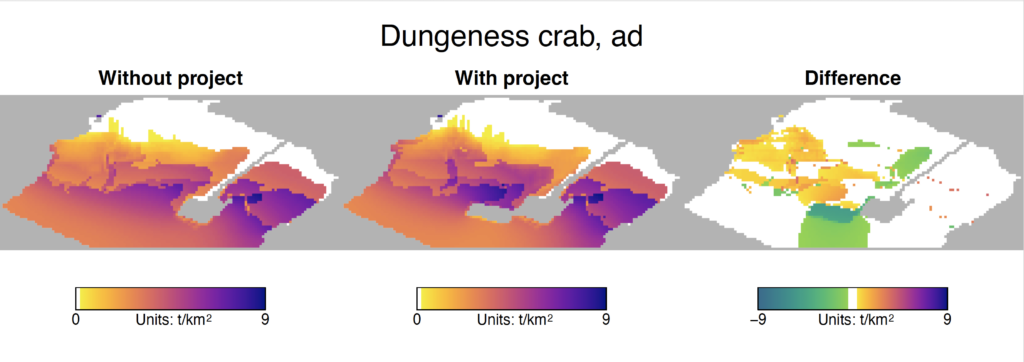Environmental impact assessment
EwE, notably Ecospace, was used extensively in preparation of the Environmental Impact Statement (EIS) for the proposed Roberts Bank Terminal 2 Project in Vancouver, British Columbia[1]. Ecospace added the capability of including environmental change as a spatial component in model simulations, and of providing output maps showing the change in biomass of all species in a food web in response to an impact and the difference between implementing the project and no action spatially (Figure 1). This provides a significant advancement from field studies and habitat description only, that are generally provided for environmental impacts statements.

Figure 1. Dungeness crab distributions without and with the Vancouver port extension, and the difference.
The Ecospace modeling approach was also used to evaluate the environmental impact of the construction of an industrial area, a road, and a wind power generator on a Natura 2000 site in Germany[2]. Ecospace was deemed to be the ideal tool for this EIS because both short and long-term impacts could be evaluated, as well as cumulative impacts of habitat loss, noise, and light pollution. In addition to evaluating impact, alternatives were evaluated to identify a strategy with the least impact, and mitigating strategies were tested, all within Ecospace[3].
Similarly, different flow regimes strategies and sediment diversion locations could be tested with the Mississippi River Delta model described in section 6.5[4], contributing to the scientific support of the decision to apply for permits of two large sediment diversions, and to put the construction of two others on hold. While Ecospace was used in the scientific studies investigating effects of coastal protection and restoration projects such as these large sediment diversions[5] [6], Ecopath with Ecosim (without Ecospace) was used to inform the official EIS[7] [8]. This decision was made because the longer history of use of Ecopath with Ecosim than Ecospace provides for a stronger case when faced with potential litigation.
Attribution
The chapter is based on de Mutsert et al.[9], adapted with permission, License Number 5651431253138. Rather than citing this chapter, please cite the source.
- https://iaac-aeic.gc.ca/050/evaluations/proj/80054 ↵
- Fretzer, S., 2016. Using the Ecopath approach for environmental impact assessment—A case study analysis. Ecological Modelling, Ecopath 30 years – Modelling ecosystem dynamics: beyond boundaries with EwE 331, 160–172. https://doi.org/10.1016/j.ecolmodel.2015.09.022 ↵
- Fretzer, 2016, op. cit. ↵
- De Mutsert et al. 2017. Using ecosystem modeling to evaluate trade-offs in coastal management: Effects of large-scale river diversions on fish and fisheries. Ecological Modelling 360, 14–26. https://doi.org/10.1016/j.ecolmodel.2017.06.029 ↵
- http://De Mutsert et al. 2017. op. cit. ↵
- De Mutsert, K., Lewis, K.A., White, E.D., Buszowski, J., 2021. End-to-End Modeling Reveals Species-Specific Effects of Large-Scale Coastal Restoration on Living Resources Facing Climate Change. Front. Mar. Sci. 8. https://doi.org/10.3389/fmars.2021.624532 ↵
- Lewis, K.A., Rose, K.A., de Mutsert, K., Sable, S., Ainsworth, C., Brady, D.C., Townsend, H., 2021. Using Multiple Ecological Models to Inform Environmental Decision-Making. Front. Mar. Sci. 8. https://doi.org/10.3389/fmars.2021.625790 ↵
- De Mutsert, K., Lewis, K.A., Sable, S., Watkins, K., Liu, B., Jung, H., Carruthers, T., Kiskaddon, E., 2022. Description of the Breton Sound Basin and Lower Pontchartrain Basin Food Web Structure and Energetics from the EwE and CASM Ecosystem Models. Coastal Protection and Restoration Authority, Baton Rouge, LA. ↵
- De Mutsert K, Marta Coll, Jeroen Steenbeek, Cameron Ainsworth, Joe Buszowski, David Chagaris, Villy Christensen, Sheila J.J. Heymans, Kristy A. Lewis, Simone Libralato, Greig Oldford, Chiara Piroddi, Giovanni Romagnoni, Natalia Serpetti, Michael Spence, Carl Walters. 2023. Advances in spatial-temporal coastal and marine ecosystem modeling using Ecopath with Ecosim and Ecospace. Treatise on Estuarine and Coastal Science, 2nd Edition. Elsevier. https://doi.org/10.1016/B978-0-323-90798-9.00035-4 ↵

